Related Research Articles

Kurma, is the second avatar of the Hindu preserver deity, Vishnu. Originating in Vedic literature such as the Yajurveda as being synonymous with the Saptarishi called Kashyapa, Kurma is most commonly associated in post-Vedic literature such as the Puranas. He prominently appears in the legend of the churning of the Ocean of Milk, referred to as the Samudra Manthana. Along with being synonymous with Akupara, the World-Turtle supporting the Earth, Kurma is listed as the second of the Dashavatara, which are the ten principal incarnations of Vishnu.

Ravana Dashagriva a demon-king of the island of Lanka and the chief antagonist in the Hindu epic Ramayana. In the Ramayana, Ravana is described as the eldest son of sage Vishrava and Kaikasi. He abducted Rama's wife, Sita, and took her to his kingdom of Lanka, where he held her in the Ashoka Vatika. Rama, with the support of vanara King Sugriva and his army of varanasi, launched a rescue operation for Sita against Ravana in Lanka. Ravana was subsequently slain, and Rama rescued his beloved wife Sita.

Rākshasa are a race of usually malevolent beings prominently featured in Hinduism, Buddhism, Jainism and Folk Islam. They reside on Earth but possess supernatural powers, which they usually use for evil acts such as disrupting Vedic sacrifices or eating humans.

Kubera also known as Kuvera, Kuber and Kuberan, is the god of wealth, and the god-king of the semi-divine yakshas in Hinduism. He is regarded as the regent of the north (Dikpala), and a protector of the world (Lokapala). His many epithets extol him as the overlord of numerous semi-divine species, and the owner of the treasures of the world. Kubera is often depicted with a plump body, adorned with jewels, and carrying a money-pot and a club.
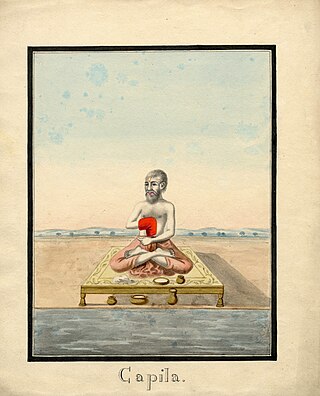
Kapila, also referred to as Cakradhanus, is a Vedic sage in Hindu tradition, regarded the founder of the Samkhya school of Hindu philosophy.
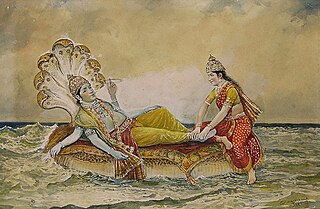
Narayana is one of the forms and epithets of Vishnu. In this form, the deity is depicted in yogic slumber under the celestial waters, symbolising the masculine principle and associated with his role of creation. He is also known as Purushottama, and is considered the Supreme Being in Vaishnavism.
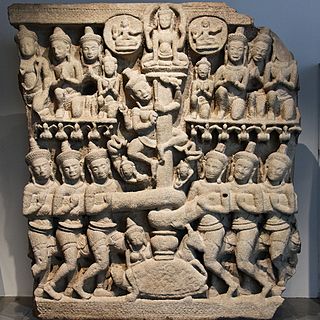
Hindu mythological wars are the wars described in the Hindu texts of ancient India. These wars depicted both mortals of great prowess as well as deities and supernatural beings, often wielding supernatural weapons of great power. Hindu teachings prescribe war as the final option, to be employed only after all peaceful methods are exhausted. Participation in righteous war, or dharmayuddha, was said to be honourable and was a principal duty of the Kshatriya or the warrior varna, and victory in such wars was regarded as a matter of honour.
In the Hindu epic, the Ramayana, Prahasta was a powerful rakshasa warrior. He was the chief commander of Ravana's army of Lanka. He was the son of Sumali and Ketumathi. In his next birth, Prahasta was reborn as Purochana in the Mahabharata as Duryodhana's trusted aide and was the main responsible for the Lakshagraha incident.
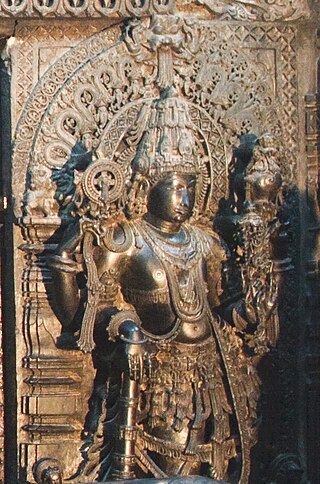
In Hinduism, Jaya and Vijaya are the two dvarapalakas (gatekeepers) of Vaikuntha, the abode of the god Vishnu. Due to a curse by the four Kumaras, they were forced to undergo multiple births as mortals who would be subsequently killed by various avatars of Vishnu. They were incarnated as Hiranyakashipu and Hiranyaksha in the Satya Yuga, Ravana and Kumbhakarna in the Treta Yuga, and finally Shishupala and Dantavakra in the Dvapara Yuga.
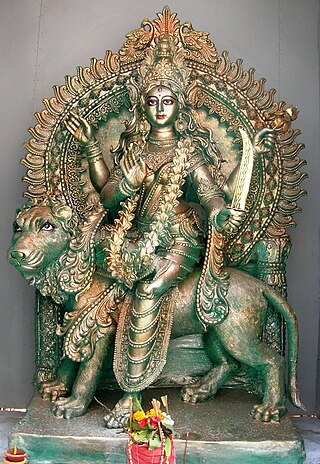
Katyayani (कात्यायनी) is an aspect of Mahadevi and the slayer of the tyrannical demon Mahishasura. She is the sixth among the Navadurgas, the nine forms of Hindu goddess Durga who are worshipped during the festival of Navaratri. She is depicted with four, ten or eighteen hands. This is the second name given to the goddess Adi Parashakti in Amarakosha, the Sanskrit lexicon.

Shurpanakha, is a rakshasi (demoness) in Hindu epic. Her legends are mainly narrated in the epic Ramayana and its other versions. She was the sister of Lanka's king, Ravana, and the daughter of the sage Vishrava and the rakshasi Kaikeshi. Shurpanakha's role in the original epic is small, yet significant.
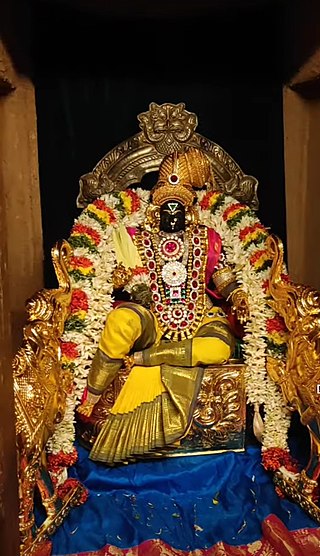
Bhumi, also known as Bhudevi, Dharani, and Vasundhara is a significant goddess in Hinduism, personifying the Earth. Her earliest form is reflected in the Vedic goddess Prithvi, though their roles and depictions are drastically different.
The Dashavatara are the ten primary avatars of Vishnu, a principal Hindu god. Vishnu is said to descend in the form of an avatar to restore cosmic order. The word Dashavatara derives from daśa, meaning "ten", and avatāra, roughly equivalent to "incarnation".

Vishnu, also known as Narayana and Hari, is one of the principal deities of Hinduism. He is the supreme being within Vaishnavism, one of the major traditions within contemporary Hinduism.

In Indian religions, Patala, denotes the subterranean realms of the universe – which are located under the earthly dimension. Patala is often translated as underworld or netherworld. Patala is described as more beautiful than Svarga. Patala is described as filled with splendid jewels, beautiful groves and lakes.
Vilambā is a bodhisattva and rakshasi in Mahayana Buddhism and the mother of Maori Xingguan in Chinese folk religion. According to Volume 7 of the Lotus Sūtra, Vilambā is one of the Ten Rākṣasīs who protect the Dharma.

Matali is the charioteer of Indra, the king of the devas, in Hinduism. He also acts as the messenger of Indra, inviting Dushyanta to help the deity in his war against the asuras in the Abhijnanashakuntalam. In the Padma Purana, Matali engages in a philosophical discourse with King Yayati regarding the nature of the soul, old age, and other concepts.

